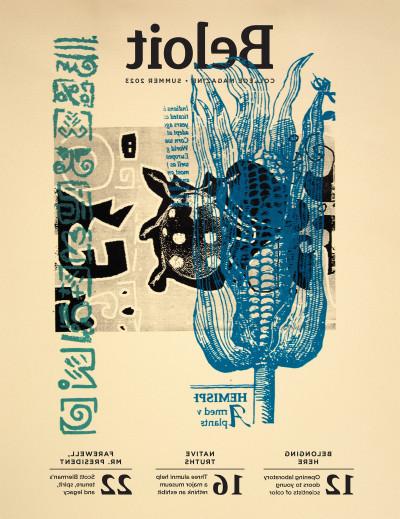Native Truths
A permanent exhibit at Chicago’s Field Museum breaks new ground in how Native American stories are told and who tells them. Three Beloiters played key roles in creating it.
Standing inside the Field Museum of Natural History’s recently revamped exhibit on Native American culture, Tom Skwerski’87 acknowledges a harsh reality.
Not only did the Field’s Native North America Hall, as it was previously known, erroneously frame Native American life as a relic of the past — offending Indigenous communities visiting the permanent exhibit — it caused irreversible damage to some of the 1,500 tribal objects on display. Skwerski, who oversaw the $8 million project at the renowned Chicago museum, explains on a recent tour of the new space that many of the pieces didn’t receive proper care and deteriorated from decades of exposure to fluorescent lights.
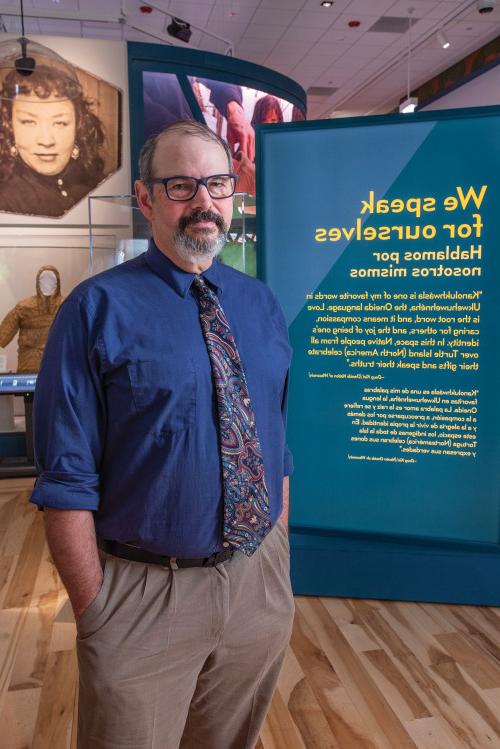
Credit: Lloyd DeGrane“It was problematic on a lot of levels, and the collections and conservation side was just one major part,” says Skwerski, the exhibitions director who’s worked at the Field since 2007.
Now the Field’s reimagined exhibit, called “Native Truths: Our Voices, Our Stories,” aims to set the record straight. Skwerski and two other Beloit alumni at the Field played crucial roles to update the 6,000-square foot exhibit, which seeks to offer a contemporary and more accurate picture of Native Americans as resilient and innovative. Emily Starck’14, an assistant collections manager, was among several new employees hired to help with the renovation. And Jamie Kelly’96, head of anthropology collections, assisted with some of the earliest fundraising and brainstorming efforts.
But the road to the redesign was not always easy. Throughout the nearly five-year process, Field staff grappled with difficult questions about museum ethics, cultural representation, and their institution’s own complicity. To bring the new exhibit to life, the Field needed to reestablish trust and include Native American communities in the process.
To that end, the Field consulted on the new exhibit with more than 130 Native American stakeholders representing more than 105 tribes. It also created an advisory panel of 11 Native American scholars and museum professionals, which met quarterly to provide input, and commissioned about 50 new works from Native artists, who were paid for their contributions, according to Skwerski. The Native Truths exhibit debuted May 20, 2022.
“One of the biggest challenges we had to face from the very beginning was coming to grips with the fact that the Field Museum has not been a welcoming place for Native people,” Skwerski says. “That’s just history. We had to change that.”
While the Field typically allots about three years to plan a new exhibit, the museum budgeted more time for this project to ensure it could incorporate feedback from Native communities, Skwerski says.
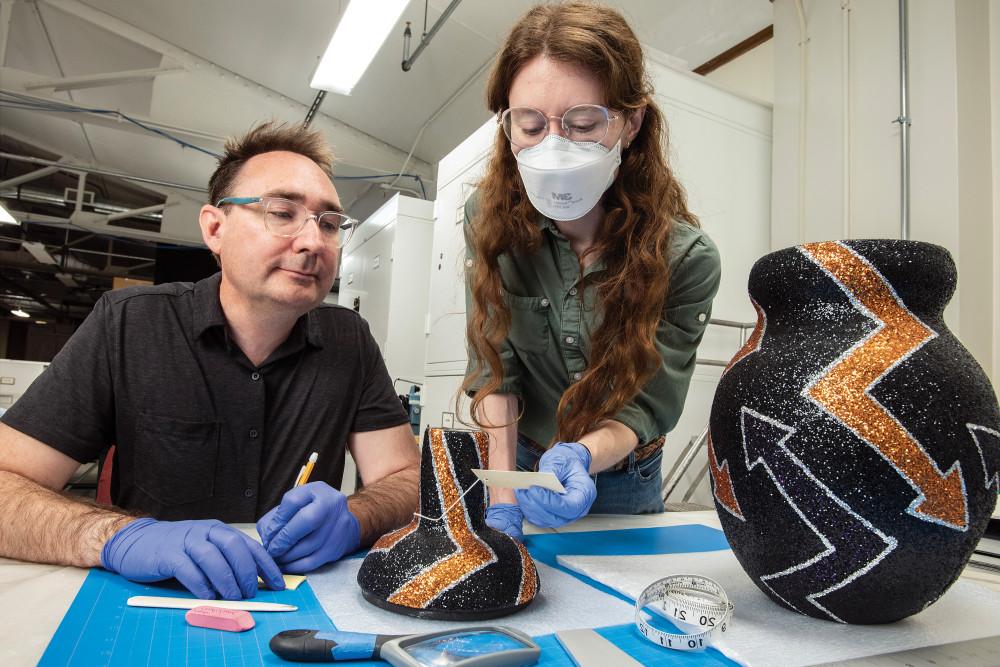
Credit: Lloyd DeGrane
The alumni also hope it marks a new era of collaboration. Starck, who now regularly helps tribes access ancestral items at the Field, said that process benefits museums trying to better understand and preserve their collections along with the communities that feel connected to them.
“Early in the 19th and 20th centuries, museums thought of themselves as the experts in cultural knowledge, but we know now that we are acting as stewards and we’re not the experts,” Starck says. “It’s been a real privilege to work with community knowledge keepers, elders, scholars, and artists who are the experts.”
A co-curated space
When the Field officially announced the redesign project in 2018, it had its work cut out.
The Native North America Hall hadn’t gotten a substantive update since it was erected in the 1950s. Many of the objects on display had been shown at the 1893 World’s Columbian Exposition, which was held in Chicago, and they later formed some of the museum’s founding collections. It was a time when anthropologists believed that by removing Native American artifacts from their original contexts, including human remains and funerary objects, they were helping preserve a dying culture.
Concerns about the outdated exhibit, expressed by people both within and outside the Field, had been mounting for years. Critics of the hall noted that mannequins used throughout the space were faceless and stuffed with newspaper, dehumanizing the Native people they were meant to portray, and that some of the information presented was inaccurate. With about 1,500 objects such as moccasins, hand-crafted Hopi Kachina dolls, and traditional garments crammed into glass display cases, there was not enough room to provide the thorough explanation the items deserved.
Formal efforts to revamp the exhibit began in 2014, says Kelly, who served on an internal task force to help conceive of the new space.
“My role was more intensive before the project was greenlit,” Kelly says. “We were just throwing ideas on the wall, brainstorming and coming up with the concepts.”
During these sessions, the Field focused on repairing relations with Native American communities. Key to that mission was creating the Native American advisory council, a group of 11 people from Indigenous backgrounds. Council members, who received an honorarium for their participation, guided the Field on everything from using Indigenous language to selecting themes featured in the exhibit’s displays.
Kelly says the task force also came up with the idea of creating rotating galleries, allowing some items to go on rest and then showcasing others. “We definitely wanted this to be a co-curated space where people are telling their stories,” Kelly says. “Our collection is so vast, there was way too much to be told in such a small space.”
As its introspection continued, the Field recognized another issue: It had no Native people working in an exhibit about their own culture. That changed as additional Native staff were hired in Collections and Conservation, and visual artist Debra Yepa-Pappan, who is Korean and a tribally enrolled member of the Pueblo of Jemez, joined the Field as its first Native community engagement coordinator. Throughout the redesign, Yepa-Pappan helped keep Chicago’s Native American community connected with the process and liaised with dozens of Native collaborators.
For Yepa-Pappan, the work is personal. She grew up in Chicago and remembers visiting the Native Hall with her father during summer vacation, each time thinking the exhibit seemed dingy compared to others housed in the cultural landmark. Most vividly, Yepa-Pappan recalls her father pointing out an object, a Pueblo man’s ceremonial kilt, that was labeled inaccurately. Based on the design, he could tell it had come from the Jemez Pueblo people and not the Cochiti people, as the display said.
“That resonated with me and stuck with me all throughout my entire life,” Yepa-Pappan says. “As I had my daughter, and as she was growing up, I really tried to avoid the Field Museum.”
Empowering Native voices
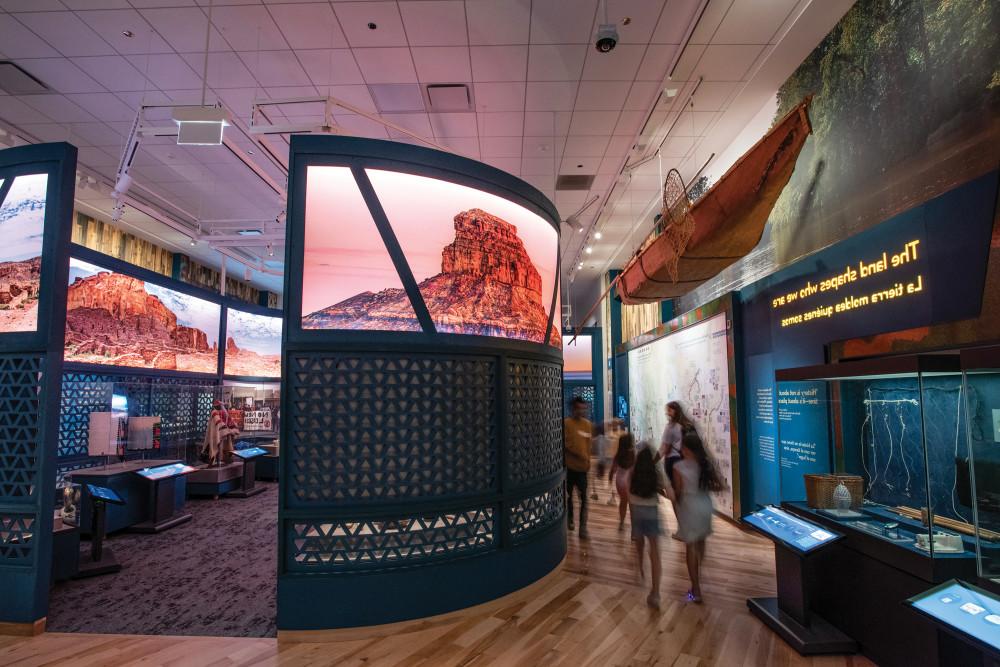
Credit: Lloyd DeGrane
Today’s exhibit is starkly different from the one Yepa-Pappan encountered as a young girl.
The new experience begins before visitors even step inside. Big, black, chunky letters that proclaim “You are on Native land” are at the exhibit entrance, setting the tone. It’s the same design as an apparel line founded by Native artist Joey Montoya, a Lipan Apache who collaborated with the Field.
The statement is a powerful reminder, Skwerski says, and it reflects the Field’s commitment to working closely with Native communities. The Field also sought to honor this approach in the materials it sourced for the rebuild, including using wood from the Menominee Indian Tribe of Wisconsin for the floors and benches.
Instead of focusing on the quantity of objects displayed, the new hall seeks to empower Native voices. The 430 pieces in the new exhibit, far fewer than the 1,500 previously shown, can be thoroughly explored. Through vibrant videos on digital touch screens, Native people act as guides to convey stories about the objects and share their experiences. Almost all of the exhibit is told from the perspective of Native people. For now, the rotating galleries touch on themes such as food sovereignty, land conservation, art as a form of expression, and the continuity of traditions.
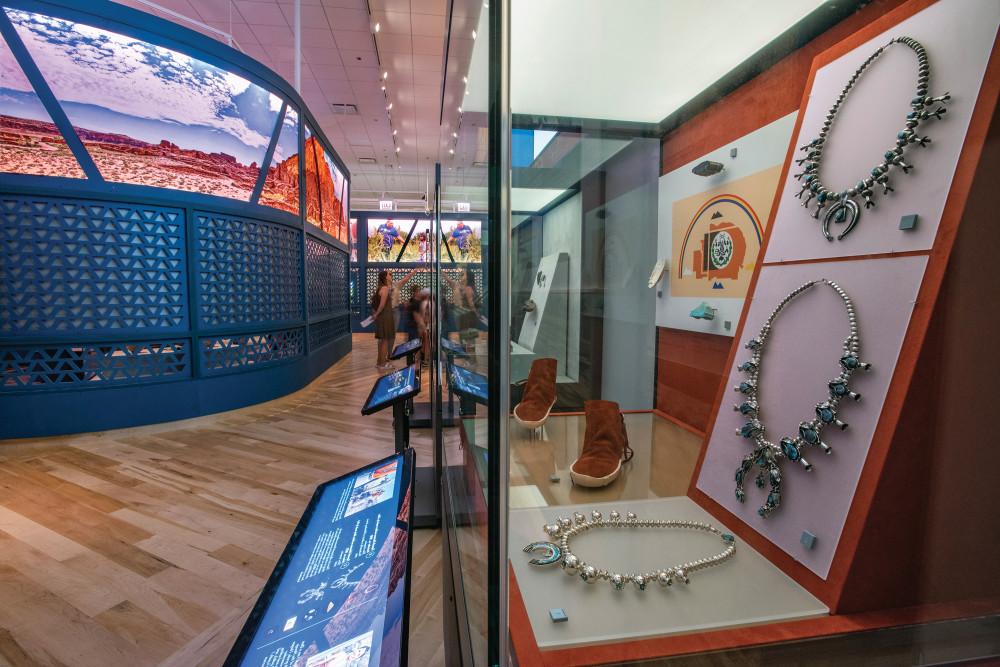
Visitors will rarely encounter the Field’s voice, with the exception of where the museum grapples with its own problematic legacy. That display acknowledges how the museum harmed Native American communities and was reluctant to repatriate some objects that Tribes had requested back, despite a federal law that required it.
“We have changed a great deal since our founding,” the display says, “but we need to change a great deal more.” In this section, the museum notes that it raced to collect human remains, particularly skulls of Native people, helping give rise to claims in the eugenics movements that Indigenous people were inferior. Another section shows how the Field is trying to reform, highlighting that the museum returned 116 funerary objects to the Sault Ste. Marie Tribe of Chippewa Indians, who reside today in Michigan.
Starck and Skwerski say sensitive issues regarding repatriations did arise during the redesign and were handled by a different museum department to protect the privacy of those involved.
“The fact that this is such a major exhibition project called more attention to the Field Museum and its collections and that’s getting the word out about items that we have here,” Starck says.
Lessons from Beloit
Though Skwerski, Starck, and Kelly contributed to different aspects of the Native Truths exhibit, they all drew on foundational experiences at Beloit to prepare them for the massive undertaking.
With two museums on campus where students receive hands-on training, Beloit offers an interdisciplinary museum studies program that prepares students to excel at leading national institutions. In addition to work-study and volunteer opportunities in Beloit’s Logan Museum of Anthropology or the Wright Museum of Art, students are required to complete an external internship.
Starck cites her time at the Logan, where she conducted research and learned to care for delicate collections, as the training ground for her work on Native Truths.
“That attitude of learning and teaching and trying to involve aspiring professionals, even from the beginning of their college career, really helped give me a solid direction in this kind of collaborative anthropology,” she says.
At Beloit, Starck and Skwerski majored in anthropology and minored in museum studies. Kelly double majored in art history and anthropology and graduated with a minor in museum studies.
Nicolette Blum Meister, museum studies program chair and Logan director, said the Field is just one of the many major cultural institutions where Beloit graduates are making a difference. Others include the Smithsonian, the Saint Louis Art Museum, the Princeton University Art Museum, and the Pleasant Prairie History Museum in Wisconsin, to name a few.
“It is distinctive to even have museum studies at the undergraduate level, but it’s our collections-rich campus that makes us stand apart from our peers,” Meister says.
Each year, between eight and 15 students are enrolled in the museum studies minor. On top of the external internship, students fulfill degree requirements by taking collections management courses, enrolling in electives on exhibit design and the chemistry of artwork, and completing a capstone project.
Skwerski and Kelly also credit Beloit with preparing them to become leaders at the Field. In creating Native Truths, they drew on skills such as critical thinking, cultural sensitivity, and exhibit design — all fundamentals of their Beloit education.
“This is probably one of the most rewarding projects that I’ve worked on,” Skwerski says. “It just really changed my view of how you can make an exhibit and who your audience is and who the voice should be.”
Elyssa Cherney is a writer based in Chicago. She has worked for the Chicago Tribune, Crain’s Chicago Business, the Orlando Sentinel, and other publications.


